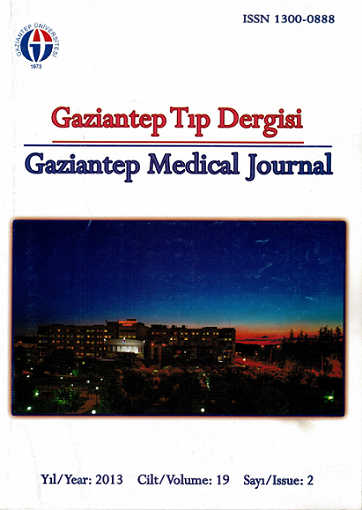Tubo-ovarian abscesses: A retrospective analysis of risk factors, clinical features, and treatments
Tubo-ovaryan abseler: Risk faktörleri, klinik özellikler ve tedavilerinin retrospektif analizi
DOI:
https://doi.org/10.5455/GMJ-30-2012-121Keywords:
Medical treatment, pelvic mass, surgical treatment, tubo-ovarian abscessAbstract
Tubo-ovarian abscess (TOA) is a serious inflammatory disease of the female reproductive system including the ovary, fallopian tube, and the surrounding tissues. In this study, we aimed to present risk factors, clinical features and treatment approaches in TOA. The files of 31 patients with a diagnosis of TOA were analyzed retrospectively from January 2007 to June 2012. The patients’ risk factors, clinical details, treatment modalities, laboratory results, and complications were recorded. The medically treated patients were divided into two groups: successful and unsuccessful treatment groups. Groups were compared according to the demographic data, risk factors, and mass characteristics. The mean age of patients was 33.12±10.43. Twenty-eight patients (90.3%) were married and 27 of them (87%) were multiparous. Intrauterine device (IUD) were used as contraceptive method in 11 of married patients (35.5%). Nine patients (29%) had history of prior intrauterine or intraabdominal intervention within 6 months. Pelvic inflammatory disease (PID) were in 15 patients (48.4%). At admission, pelvic pain in 31 (100%), vaginal discharge in 24 (77.4%), fever in 17 (54.8%), irregular menstrual bleeding in 14 (45.2%) of patients were recorded. Laboratory findings were elevated erythrocyte sedimentation rate (71%), and increased C-reactive protein level (71%), leukocytosis (61.3%) respectively. The initial diagnosis of hospitalized patients were observed TOA in 14 (45.2%), ruptured TOA in 5, IUD translocation and TOA in 7, the suspicion of a complication of perforated appendicitis in 1 and pelvic mass (teratoma, fibroid degeneration, ovarian cancer, endometrioma) in 4 of patients, respectively. Medical treatment was applied in 13 patients and reached 46.2% success rate. There was no significant difference in between successful and unsuccessful treatment groups with respect of demographic data, risk factors, and the mass characteristics. Surgical procedures were laparoscopic abscess drainage (22.6%), laparotomy and drainage of abscess (32.3%), unilateral salpingooopherectomy (12.9%), and total abdominal hysterectomy and bilateral salpingo-ooferectomy (12.9%), respectively. The bowel injury and sepsis (6.5%), dehiscence (6.5%), and wound infection (3.25%) were observed as postoperative complications. The pelvic masses may be a risk factor in addition to PID and the use of IUD for TOA. The patients with TOA may present with the pelvic mass and pelvic pain without the classic symptoms of infection. Therefore, TOA should be considered in the differential diagnosis of pelvic masses. Although the medical treatment should be the first choice in patients with TOA, suspected cases and ruptured abscesses should be treated by surgery.
Metrics
References
Whiteman MK, Kuklina E, Jamieson DJ, Hillis SD, Marchbanks PA. Inpatient hospitalization for gynecologic disorders in the United States. Am J Obstet Gynecol 2010;202(6):541.e1-6.
Loscalzo J, Andreoli TE, Cecil RL, Carpenter CA, Griggs RC. Cecil essentials of medicine. Philadelphia: W.B. Saunders,
Quan M. Pelvic inflammatory disease: diagnosis and management. J Am Board Fam Pract 1994;7(2):110-23.
Hiller N, Sella T, Lev-Sagi A, Fields S, Lieberman S. Computed tomographic features of tuboovarian abscess. J Reprod Med 2005;50(3):203-8.
Reed SD, Landers DV, Sweet RL. Antibiotic treatment of tuboovarian abscess: comparison of broad-spectrum β-lactam agents versus clindamycin-containing regimens. Am J Obstet Gynecol 1991;164(6 Pt 1):1556–61.
Wiesenfeld HC, Sweet RL. Progress in the management of tuboovarian abscesses. Clin Obstet Gynecol 1993;36(2):433-44.
Landers DV, Sweet RL. Tubo-ovarian abscess: Contemporary approach to manangement. Rev Infect Dis 1983;5(5):876-84.
Golub V, Kim AC, Krol V. Surgical wound infection, tuboovarian abscess, and sepsis caused by Edwardsiella tarda: case reports and literature review. Infection 2010;38(6):487-9.
Felz MW, Apostol CJ. Fatal pneumococcal sepsis from a tuboovarian abscess. J Am Board Fam Pract 2004;17(1):68-70.
Wagner A, Russell C, Ponterio JM, Pessolano JC. Ruptured tuboovarian abscess and septic shock with Clostridium perfringens in a postmenopausal woman: a case report. J Reprod Med. 2009;54(10):652-4.
Powers K, Lazarou G, Greston WM, Mikhail M. Rupture of a tuboovarian abscess into the anterior abdominal wall: a case report. J Reprod Med 2007;52(3):235-7.
Karakulak M, Pala HG, Aydın Y, Saatli B, Güçlü S. Tuboovarian abseli olguların değerlendirilmesi. DEÜ Tıp Fakültesi Dergisi 2008;22(1): 9-13.
Çelik Ç, Görkemli H, Çiçek N, Acar A, Köşüş A, Akyürek C. Evaluation of the cases with tuboovarian abscess. Gynecol Obstet Reprod Med 2002;8(4):219-22.
Rosen M, Breitkopf D, Waud K. Tubo-ovarian abscess management options for women who desire fertility. Obstet Gynecol Surv 2009;64(10):681-9.
Hsiao SM, Hsieh FJ, Lien YR. Tuboovarian abscesses in postmenopausal women. Taiwan J Obstet Gynecol. 2006;45(3):234-8.
Workowski KA, Berman SM. CDC, PID- STD Treatment Guidelines 2006. MMWR 2006;55:RR-II.
Ginsburg DS, Stern JL, Hamod KA, Genadry R, Spence MR. Tubo-ovarian abscess: a retrospective review. Am J Obstet Gynecol 1980;138(7 pt 2):1055–8.
Henry-Suchet J, Soler A, Loffredo V. Laparoscopic treatment of tuboovarian abscesses. J Reprod Med 1984;29(8):579–82.
Sweet RL. Infectious diseases of the female genital tract. Sweet RL, Gibbs RS, Lippincott Williams and Wilkins, Philadelphia 2009.
Downloads
Published
How to Cite
Issue
Section
License
Copyright (c) 2023 European Journal of Therapeutics

This work is licensed under a Creative Commons Attribution-NonCommercial 4.0 International License.
The content of this journal is licensed under a Creative Commons Attribution-NonCommercial 4.0 International License.


















